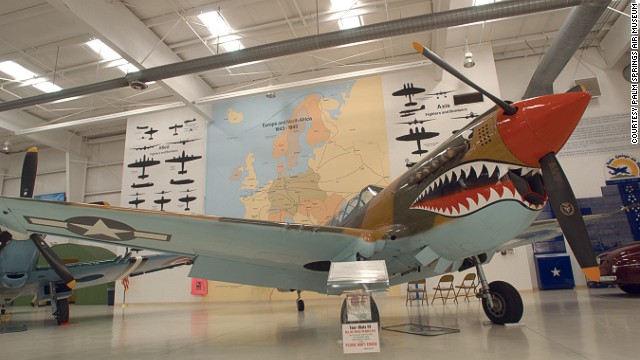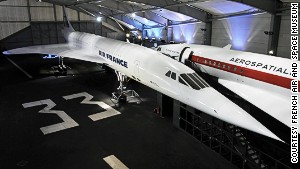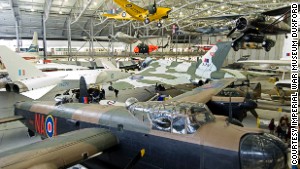February 7, 2014 -- Updated 2154 GMT (0554 HKT)
STORY HIGHLIGHTS
- Smithsonian National Air and Space museum contains Space Shuttle
- Salzburg's Red Bull Hangar-7 is one of the most beautiful aviation museums
- A collection of retired planes make up Pima Air & Space Museum's popular "Boneyard"
- Panel of aviation experts helped us pick the best museums
(CNN) -- Recent months have brought important anniversaries in the world of aviation.
Orville Wright completed the world's first powered flight on December 14, 1903. (Debate persists on whether the first "successful" powered flight took place on December 14 or December 17 of 1903. Though others disagree,thewrightbrothers.org website recognizes October 14 as the first of the Wright Brother's first five flights.)
The first commercial flight, from St. Petersburg, Florida, to Tampa, Florida, took place in January 1914.
That 23-minute flight, for which most passengers paid $5 each, took place in a wood and muslin biplane flying boat.
In other words, not much worse than a few budget airline flights we've endured in the modern era.
The world's best aviation museums capture the achievements and products of the pilots, designers and engineers who got us from those rickety first flights to space travel and people clipping their toenails next to us in seat 17B.
Thankfully, there's no need to fasten your seat belt, shut off phones or worry about turbulence and legroom to enjoy the world's best aviation museums.
Just enjoy the ride.
Did we miss your favorite aviation museum? Disagree with our ranking? Share your opinions and recommendations in the comments below.
14. Palm Springs Air Museum (California, United States)
In Palm Springs, exhibits with no ropes.
Palm Springs Air Museum is small, but that's a good thing.
It's one of the few where you can climb inside the exhibits, talk to a pilot or enjoy a biplane ride.
"We love to bring in temporary exhibits -- our fleet of aircraft are not static, and there are no ropes to prevent visitors from getting up close," says managing director Fred Bell.
"Our 8,700-volume library consists of first-person narratives, including an 800-volume collection of books devoted to the China-Burma-India Theater of Operations during World War II.
"We are a living history museum, and it's not uncommon for visitors to speak to someone who flew one of our aircraft in either Korea or Vietnam."
Palm Springs Air Museum, 745 N. Gene Autry Trail, Palm Springs, California; +1 760 778 6262
13. Central Museum of the Air Forces (Monino, Russia)
A shrine to Cold War aviation, this museum 24 miles outside of Moscow is considered Russia's best.
"The whole thing does have a unique charm that is rather difficult to quantify," says aviation author and researcher Andy Saunders.
Outdoor exhibits at the once operational air base showcase Russian jets from the 1960s and '70s.
There are military Mikoyans (MiGs), Tu-142 bombers, Tu-22 bombers and a Tu-144 supersonic passenger plane.
The flight uniform Francis Gary Powers wore when his U-2 spy plane was shot down over the Soviet Union during a reconnaissance mission is on display.
Retired air force officers, who have stories and personal anecdotes to share, guide the museum tours.
Central Museum of the Air Forces, Monino, Russia
12. Royal Flying Doctor Service Museum (Alice Springs, Australia)
The Royal Flying Doctor Service (RFDS) museum is housed inside what was once the RFDS radio house.
Visitors can peer inside a Pilatus PC12, the aircraft used by the service.
There's also a display of historic radios and medical equipment.
In the 70-seat theater, visitors hear amazing stories of survival from those who've been visited by the flying doctors.
"The service was founded by a minister, Reverend John Flynn, in 1928," says museum manager Andrew Rutter.
"Reverend Flynn envisaged a 'mantle of safety' that provided healthcare to Australians, wherever they lived. The story began with a de Havilland DH50 leased in 1928 from the then fledgling Queensland and Northern Territory Aerial Service, which later became Qantas."
Royal Flying Doctor Service museum, Alice Springs, Australia; +61 (0)8 8958 8411
11. Red Bull Hangar-7 (Salzburg, Austria)
Owned by Red Bull founder and billionaire Dietrich Mateschitz, Red Bull Hangar-7 is one of the world's most beautiful aviation museums.
The main building -- made from 1,200 tons of steel and 380 tons of glass -- contains Red Bull's fleet of Flying Bull stunt planes, a rare Cessna C337, a Boeing PT-17 (known as the Harley Davidson of the sky) and three 1,000-kilometer-per-hour Alpha jets, which were purchased by Red Bull's stunt team from the German air force.
It also has collections of F1 cars, motorbikes and plants.
Between the speed machines, visitors can spot some of the world's rarest greenery, including swamp date palms from Indochina, mulberry weeping figs and Japanese Kusamaki trees.
Red Bull Hangar-7, Wilhelm-Spazier-Straße 7a, 5020 Salzburg, Austria; +43 662 2197
Surely there's a Canadian maple leaf stamped somewhere on there.
10. Canada Aviation and Space Museum (Ottawa, Canada)
Home to more than 130 aircraft from around the world, highlights here include the nose section of an Avro Canada CF-105 Arrow (one of few remaining parts of the Canadian-built fighter jet) and a flight simulator.
In summer, visitors can take short flights in a 1939 Waco UPF-7 biplane.
"Our collection features original aircraft as opposed to reproduced versions," points out Stephen Quick, the museum's director general.
"Only in Ottawa can you see Professor Junker's first all-metal aircraft from 1917, an HS2L flying boat resurrected from Canada's lakes and the prototype de Havilland Canada Beaver."
Canada Aviation and Space museum, 11 Aviation Parkway, Ottawa; +1 613 993 2010
9. China Aviation Museum (Beijing)
More than 200 aircraft are collected at China's flagship aviation museum, including Chinese fighter jets, a replica of the "Wright Flyer" and the plane that was once Chairman Mao's personal transport.
The setting is spectacular -- part of the museum is housed within a cave that was originally part of the underground bunker system of China's Shahe airbase.
"There are some truly extraordinary aircraft -- ones you just cannot and do not see in the West," says aviation expert Michael Blank.
"My favorite exhibits are the 'prop liners' -- old propeller-driven airliners, like the Ilyushin 18s."
China Aviation Museum, Changping, Beijing; +86 10 6178 4882
8. Polish Aviation Museum (Krakow, Poland)
Communist-era aircraft dominate here.
Everywhere you look outside the Krakow museum there's a string of Soviet-era, Cold-War jets.
Inside you'll find well-conserved displays of accompanying memorabilia.
The museum has a huge collection of aircraft.
"It houses a remarkable display of un-restored, pre-World War I aircraft still in the tattered state in which they were rediscovered in Poland at the end of World War II, having been spirited away from the great Deutsche Luftfahrtsammlung in Berlin to save them from Allied bombing," says Michael Oakey, managing editor at The Aviation Historian.
The museum is located on Rakowice-Czyżny, one of the oldest military airfields in Europe; the airfield played a part in defending the Krakow Fortress during World War I.
The base served as a pilot school during the 1920 Polish-Soviet War and by the late 1920s it had become the second largest air base in Poland.
"It's one for the connoisseur, with a time-capsule of untouched pre-World War I aircraft, plus a rare example (from the 1970s) of the world's only production jet-powered biplane," says Oakey of the PZL M-15 Belphegor.
Polish Aviation Museum, 31-864 Kraków, al. Jana Pawła II 39
7. Pima Air & Space Museum (Arizona, United States)
Pima Air & Space Museum is the largest non-government funded aviation museum in the United States.
Exhibits include the SR-71 Blackbird (the world's fastest spy plane), a B-29 Superfortress and the world's smallest biplane.
In one area, planes double as canvases for Brazilian graffiti artist Nunca.
One of the most popular attractions is the Boneyard, otherwise known as the place planes go to die.
The 309th Aerospace Maintenance and Regeneration Group (to give the area its correct name) covers 2,600 acres (or 1,430 soccer pitches) and contains the rusting hulks of 4,000 retired aircraft.
Pima Air & Space Museum, 6000 E. Valencia Road, Tucson, Arizona; +1 520 574 0462
6. State Aviation Museum of Ukraine (Kiev, Ukraine)
This museum houses one of the world's biggest displays of aviation technology.
The museum is operated by Ukraine's National Aviation University, which uses the site for training and education.
The majority of the aircraft are ones built by the Soviet Union and exhibits include supersonic bomber planes, transport planes and nuclear missile carriers.
One of the most impressive exhibits is the Tupolev-104.
"On September 15, 1956, a very important event for civil aviation occurred," explains Professor Felix Yanovsky, head of electronics at the National Aviation University.
"The world's first jet airliner, the Tupolev-104, made its first passenger flight between Moscow and Irkutsk. This plane is now in the State Aviation Museum of Ukraine, and it's the oldest surviving aircraft of this type."
State Aviation Museum of Ukraine, Zhulyany Airport in Kiev, Ukraine; +380 451 83 24
Concordes: Long-haul passengers would rejoice if these would fly again.
5. French Air and Space Museum (Le Bourget, France)
It covers 1.6 million square feet and contains 19,595 exhibits -- some of which date to the 16th century.
It houses the only known remaining piece of the L'Oiseau Blanc, the aircraft used by Charles Nungesser and François Coli in their attempt to make the first transatlantic crossing from Paris to New York in 1927, two weeks before Charles Lindbergh's successful flight in the opposite direction.
They took off from Paris, but were never seen again.
This museum is the only place you can see two Concordes side by side.
"The highlight is the Concordes," says Graham Braithwaite, an aviation professor at the UK's Cranfield University.
"They're a reminder of the technical achievement that united the British and French.
"It's poignant to see them so close to where the Air France Concorde crashed with the loss of all on board -- the beginning of the end for this remarkable aircraft."
French Air and Space Museum, Le Bourget, Paris; +33 1 49 92 70 00
4. Future of Flight Aviation Center and Boeing Tour (Washington, United States)
If you want to design your own jet or sit in a simulator to experience a Battle of Iwo Jima dogfight, this is the place to go.
The main attraction is a tour of Boeing's enormous assembly plant, housed inside a factory the size of Disneyland.
"The museum is unique because most exhibits are designed to be touched," says director Sandy Ward.
"The most notable exhibits are a one-piece composite test barrel of a Boeing 787 Dreamliner and the largest airplane engine in the world, which is a GE 90 Boeing 777 engine.
"The center's claim to fame, though, is the Boeing jumbo jet assembly plant tour where the jet maker builds 747, 777 and 787 Dreamliners."
Future of Flight Aviation Center and Boeing Tour; 8415 Paine Field Blvd., Everett, Washington; +1 425 438 8100
3. National Museum of the United States Air Force (Ohio, United States)
The world's biggest and oldest military aviation museum at Wright-Patterson Air Force Base in Ohio, is huge, but well ordered.
"Its sheer scale is extraordinary -- it has about 17 acres of indoor display space, spread across several hangars and other buildings; and further outdoor display space for some of its larger aircraft," says Michael Oakey, managing editor at The Aviation Historian.
"You need at least a couple of days to get around it all."
The museum's lighting and exhibit presentation are extraordinary.
Exhibit galleries are divided by era.
In the early years, a SPAD XIII and Caproni CA 36 bomber are on display.
In the World War II gallery, there's the B-17F "Memphis Belle," the first U.S. Army heavy bomber to complete 25 missions over Europe and return stateside with its crew intact.
It was the inspiration for the 1990 film of the same name.
The keystone of the museum's presidential gallery is the Boeing VC-137C.
Known as SAM (Special Air Mission) 26000, it was the aircraft serving as Air Force One the day president John F. Kennedy was shot.
National Museum of the USAF, 1100 Spaatz St., Wright-Patterson AFB, Ohio (near Dayton)
Duxford: Where's the sign up to fly one of these classics?
2. Imperial War Museum Duxford (Duxford, UK)
Once a British Royal Air Force station, the museum at Duxford is often mentioned in "best aviation museums" lists, and is particularly noteworthy for its world-leading collection of WWII planes.
"The thing that makes this place is, firstly, atmosphere; an original WWI and WWII military airfield that is now a living museum," says aviation author and researcher Andy Saunders.
"The fact that Spitfires, Me 109s, B-17s and P-51 aircraft can regularly be seen flying here (and not just during air display days) makes this place the ultimate museum of its genre."
Duxford's airdrome has played many roles.
It was a site for training Royal Flying Corps in 1917.
Later it became a base for squadron disbandment and then a fighter station in 1924.
It's home to Spitfires, a Lancaster bomber and a Concorde and visitors can get a close look at how aircraft like these are restored through the Conservation in Action program.
"You can watch as what are often ruined hulks are restored to apparently immaculate examples of aircraft -- some of which are the only ones in existence," says professor Graham Braithwaite of Cranfield University.
The summer season air shows at Duxford are arguably the best in the world, with zippy, acrobatic displays from iconic aircraft.
This year the museum will commemorate 70 years since D-Day in Normandy (June 6, 1944) with a special anniversary air show.
Visitors can also take a flying lesson in a vintage Warbird T6 Harvard while a Spitfire flies in formation alongside.
Imperial War Museum, Duxford, Cambridge; +44 1223 835000
1. Smithsonian National Air and Space Museum (Washington, D.C.)
It's the sheer number of aircraft and artifacts that make this Washington, D.C., museum beloved by both the aviation-obsessed and the marginally curious.
"It's a museum that seems to have life and soul and I would challenge anyone with an inquiring mind, whether aviation enthusiast or not, not to find something here that engages and interests them," says aviation author and researcher Andy Saunders.
Eight million people every year visit the 60,000 exhibits and a public archive of more than 1.75 million photographs and 14,000 videos detailing aviation and space.
It has the world's first airplane, the "Wright Flyer" that made its debut flight at Kitty Hawk in 1903, front and center in an exhibit dedicated to the onset of the aerial age.
Then there's the Apollo 11 Command Module, "Columbia," which brought Buzz Aldrin, Neil Armstrong and Michael Collins home after the world's first moon walk -- it was the only part of the spacecraft that made it back to Earth.
The museum's companion facility, the Udvar-Hazy Center, contains the Space Shuttle Discovery and the Boeing B-29 Superfortress bomber "Enola Gay," the aircraft that dropped an atomic bomb on Hiroshima during World War II.
"The Smithsonian collection is the world's best," says Tom D. Crouch, senior curator of aeronautics at the National Air and Space Museum. "Not to recognize that is simply not to be paying attention."
National Air and Space Museum, Independence Ave at 6th St. SW, Washington, D.C.


 This small museum in Palm Springs, California, is one of the few where you can climb inside exhibits, talk to a pilot or take a biplane ride.
This small museum in Palm Springs, California, is one of the few where you can climb inside exhibits, talk to a pilot or take a biplane ride.



No comments:
Post a Comment